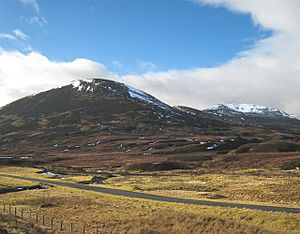Battle of Dalnaspidal facts for kids
Quick facts for kids Battle of Dalnaspidal |
|||||||
|---|---|---|---|---|---|---|---|
| Part of Wars of the Three Kingdoms | |||||||
 Dalnaspidal |
|||||||
|
|||||||
| Belligerents | |||||||
| Commanders and leaders | |||||||
| Sir Thomas Morgan Marquess of Argyll |
Earl of Glencairn Earl of Middleton |
||||||
| Strength | |||||||
| Unknown | 1,200 foot 800 horse |
||||||
| Casualties and losses | |||||||
| Unknown. | Unknown | ||||||
The Battle of Dalnaspidal was a fight that happened on 19 July 1654. It was part of the Wars of the Three Kingdoms, a series of conflicts across Britain and Ireland. This battle was one of the last major events in a rebellion by Scottish Royalists between 1653 and 1654. The Royalists supported King Charles II, while the English Commonwealth was led by Oliver Cromwell.
How the Battle Started
Before the battle, the Earl of Glencairn gathered soldiers from the Clan MacGregor in a place called Rannoch. It was easy for him to get their help because one of their main enemies was the Earl of Argyll, who belonged to the Campbell clan. The MacGregors and Campbells had a long history of fighting.
Another leader, Alexander, the 12th chief of Clan Robertson, also brought his men to join Glencairn. Both groups of soldiers met up and then marched along an old path towards Loch Garry.
The Battle of Dalnaspidal
On the evening of 19 July 1654, the Royalist forces were surprised. Sir Thomas Morgan, leading the English Commonwealth troops, attacked them at Dalnaspidal. This area is near Loch Garry, in a mountain pass called Drumochter Pass.
At the time of the attack, the Royalist cavalry (soldiers on horseback) had become separated from their infantry (soldiers on foot). When Morgan's larger forces moved towards them, most of the Royalist cavalry quickly ran away. This left their foot soldiers without protection. As Morgan's cavalry kept moving forward, the Royalist infantry also turned and fled.
What Happened After
The defeat at Dalnaspidal effectively ended the Royalist rebellion in the Scottish Highlands. Even though he was injured, Middleton managed to escape into the mountains. However, he could never again gather a large enough army to continue the fight.
George Monck, a general for the Commonwealth, wanted the leaders of the rebellion to be executed. But Oliver Cromwell, who was the Lord Protector, and his Council offered a pardon to anyone who surrendered. This offer was known as Cromwell's Act of Grace.
In September 1654, William, Earl of Glencairn, surrendered to General Monck. Middleton, however, escaped from Scotland and went back to Europe. He rejoined King Charles II in Cologne early in 1655.

